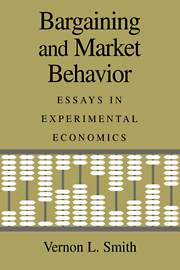Book contents
- Frontmatter
- Contents
- Preface
- Part I Economics and Psychology
- Part II Bargaining Theory, Behavior, and Evolutionary Psychology
- Part III Institutions and Markets
- INTRODUCTION
- 10 Reflections on Some Experimental Market Mechanisms for Classical Environments
- 11 Experimental Methods in the Political Economy of Exchange
- 12 Individual Rationality, Market Rationality, and Value Estimation
- 13 Market Contestability in the Presence of Sunk (Entry) Costs
- 14 The Boundaries of Competitive Price Theory: Convergence, Expectations, and Transaction Costs
- 15 Off-Floor Trading, Disintegration, and the Bid–Ask Spread in Experimental Market
- 16 Bertrand-Edgeworth Competition in Experimental Markets
- 17 An Experimental Examination of the Walrasian Tâtonnement Mechanism
- Part IV Stock Markets and Bubbles in the Laboratory
- References
- Index
14 - The Boundaries of Competitive Price Theory: Convergence, Expectations, and Transaction Costs
Published online by Cambridge University Press: 29 October 2009
- Frontmatter
- Contents
- Preface
- Part I Economics and Psychology
- Part II Bargaining Theory, Behavior, and Evolutionary Psychology
- Part III Institutions and Markets
- INTRODUCTION
- 10 Reflections on Some Experimental Market Mechanisms for Classical Environments
- 11 Experimental Methods in the Political Economy of Exchange
- 12 Individual Rationality, Market Rationality, and Value Estimation
- 13 Market Contestability in the Presence of Sunk (Entry) Costs
- 14 The Boundaries of Competitive Price Theory: Convergence, Expectations, and Transaction Costs
- 15 Off-Floor Trading, Disintegration, and the Bid–Ask Spread in Experimental Market
- 16 Bertrand-Edgeworth Competition in Experimental Markets
- 17 An Experimental Examination of the Walrasian Tâtonnement Mechanism
- Part IV Stock Markets and Bubbles in the Laboratory
- References
- Index
Summary
“Boundary experiments are explicitly associated with some set of laws and consist of fact-finding inquiries designed to fix the range and application of the laws, particularly with regard to extreme conditions” (Kaplan, 1964, p. 150). In the laboratory experiments reported here, we probed three distinct boundaries of the application of the law of supply and demand in markets organized as double auctions.This “law” of competitive market behavior predicts that prices will occur at a level where the quantity supplied by sellers (positively related to price) is equal to the quantity demanded by buyers (negatively related to price).Any price where quantity demanded equals quantity supplied is referred to as a competitive equilibrium (CE) price; the corresponding exchange volume is referred to as the CE quantity.The specific design parameters utilized in our experimental markets were chosen to address the following research questions.
1. In trading between b buyers and s sellers, how small must s be to invalidate the application of the law of supply and demand as a predictor of market outcomes?
2. In a market where the law of supply and demand predicts that all gains from exchange will be earned by only one side of the market (either buyers or sellers), will actual contract prices converge to the price predicted by the law of supply and demand? What minimal compensation will subjects on the other (zero profit) side of the market need to induce them to participate in trade?
3. In a market where any feasible price is also a CE price (generated by an unorthodox box-shaped supply and demand configuration where the quantity demanded equals the quantity supplied at all prices between the upper and lower bounds of…
- Type
- Chapter
- Information
- Bargaining and Market BehaviorEssays in Experimental Economics, pp. 286 - 319Publisher: Cambridge University PressPrint publication year: 2000
- 8
- Cited by



